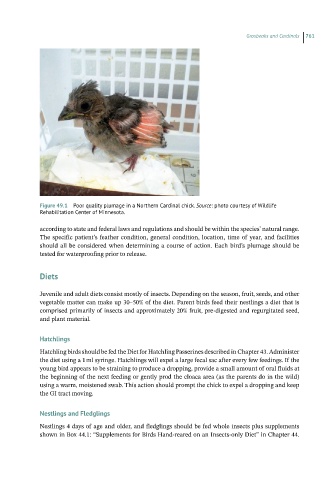Page 758 - Hand rearing birds second
P. 758
Grosbeaks and Cardinals 761
Figure49.1 Poor quality plumage in a Northern Cardinal chick. Source: photo courtesy of Wildlife
Rehabilitation Center of Minnesota.
according to state and federal laws and regulations and should be within the species’ natural range.
The specific patient’s feather condition, general condition, location, time of year, and facilities
should all be considered when determining a course of action. Each bird’s plumage should be
tested for waterproofing prior to release.
Diets
Juvenile and adult diets consist mostly of insects. Depending on the season, fruit, seeds, and other
vegetable matter can make up 30–50% of the diet. Parent birds feed their nestlings a diet that is
comprised primarily of insects and approximately 20% fruit, pre‐digested and regurgitated seed,
and plant material.
Hatchlings
Hatchling birds should be fed the Diet for Hatchling Passerines described in Chapter 43. Administer
the diet using a 1 ml syringe. Hatchlings will expel a large fecal sac after every few feedings. If the
young bird appears to be straining to produce a dropping, provide a small amount of oral fluids at
the beginning of the next feeding or gently prod the cloaca area (as the parents do in the wild)
using a warm, moistened swab. This action should prompt the chick to expel a dropping and keep
the GI tract moving.
Nestlingsand Fledglings
Nestlings 4 days of age and older, and fledglings should be fed whole insects plus supplements
shown in Box 44.1: “Supplements for Birds Hand‐reared on an Insects‐only Diet” in Chapter 44.

